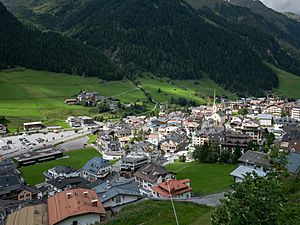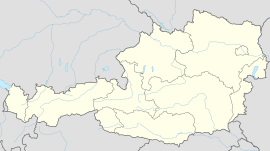Ischgl facts for kids
Quick facts for kids
Ischgl
|
||
|---|---|---|
 |
||
|
||
| Country | ||
| State | Tyrol | |
| District | Landeck | |
| Area | ||
| • Total | 103.34 km2 (39.90 sq mi) | |
| Elevation | 1,377 m (4,518 ft) | |
| Time zone | UTC+1 (CET) | |
| • Summer (DST) | UTC+2 (CEST) | |
| Postal code |
6561
|
|
| Area code | 05444 | |
| Vehicle registration | LA | |
| Website | www.ischgl.tirol.gv.at | |
Ischgl is a small town in the Paznaun valley in Austria. It is located in the state of Tyrol, which is known for its beautiful mountains. Ischgl is famous for its large ski resort, which connects to another resort in Switzerland.
Contents
Skiing and Snowboarding Fun
Ischgl is part of one of the biggest ski areas in the world. It has about 238 kilometers (148 miles) of ski slopes. These slopes are well-prepared for skiing and snowboarding.
Lifts and Slopes
Over 45 different lifts help people get up the mountains. These include big cable cars, gondolas, and chair lifts. There are also some T-bars. Three main lifts take you from the village up to the ski area.
Many lifts meet at a place called Idalp. Here, you can find a restaurant to grab a bite. The area above Idalp has wide, easy slopes, perfect for beginners. It also has a fun snow park for tricks.
Other parts of the ski area, like Höllboden and Paznauner Thaya, have more challenging slopes. These are often called "red runs" for intermediate skiers. There are also some "black runs" for expert skiers. The steepest run is in the Höllboden area.
Ischgl and the Pandemic
In 2020, Ischgl became well-known because many people got sick there during the COVID-19 pandemic. This event led to many people getting sick in other countries too.
What Happened
Health officials found that many cases of illness were linked to a bar in Ischgl. People believe that sharing whistles at the bar might have helped the illness spread. Even when other countries warned about traveling to Ischgl, the resort stayed open for a while.
The bar was eventually closed on March 10, 2020. The whole town of Ischgl was then put under quarantine. This meant people could not leave or enter the town easily. The quarantine lasted from March 13 to April 22, 2020.
Impact on the Town
Out of about 1,600 people living in Ischgl, two sadly passed away. Nine people needed hospital care, and one was in intensive care. Later, tests showed that many people in Ischgl had developed special protections in their bodies against the illness.
Weather in Ischgl
Ischgl has a weather station high up in the mountains. The climate here is an alpine climate. This means it has cold winters and cool summers. The warmest month usually has an average temperature of about 9.9 degrees Celsius (49.8 degrees Fahrenheit).
| Climate data for Ischgl (1991−2020 normals, extremes 1991−2020) | |||||||||||||
|---|---|---|---|---|---|---|---|---|---|---|---|---|---|
| Month | Jan | Feb | Mar | Apr | May | Jun | Jul | Aug | Sep | Oct | Nov | Dec | Year |
| Record high °C (°F) | 8.6 (47.5) |
9.1 (48.4) |
10.0 (50.0) |
12.6 (54.7) |
19.0 (66.2) |
24.4 (75.9) |
22.8 (73.0) |
23.0 (73.4) |
19.6 (67.3) |
17.5 (63.5) |
14.2 (57.6) |
9.8 (49.6) |
24.4 (75.9) |
| Mean daily maximum °C (°F) | −2.2 (28.0) |
−2.6 (27.3) |
0.0 (32.0) |
3.2 (37.8) |
7.2 (45.0) |
11.2 (52.2) |
13.3 (55.9) |
12.3 (54.1) |
9.0 (48.2) |
6.1 (43.0) |
1.4 (34.5) |
−1.5 (29.3) |
4.8 (40.6) |
| Daily mean °C (°F) | −5.3 (22.5) |
−5.8 (21.6) |
−3.4 (25.9) |
−0.4 (31.3) |
3.8 (38.8) |
7.7 (45.9) |
9.8 (49.6) |
9.9 (49.8) |
6.3 (43.3) |
3.6 (38.5) |
−1.3 (29.7) |
−4.5 (23.9) |
1.7 (35.1) |
| Mean daily minimum °C (°F) | −8.0 (17.6) |
−9.8 (14.4) |
−6.7 (19.9) |
−4.0 (24.8) |
0.3 (32.5) |
3.9 (39.0) |
5.9 (42.6) |
5.7 (42.3) |
2.8 (37.0) |
0.4 (32.7) |
−4.0 (24.8) |
−7.2 (19.0) |
−1.7 (28.9) |
| Record low °C (°F) | −23.5 (−10.3) |
−26.6 (−15.9) |
−23.2 (−9.8) |
−18.7 (−1.7) |
−11.6 (11.1) |
−7.7 (18.1) |
−2.7 (27.1) |
−3.9 (25.0) |
−6.4 (20.5) |
−14.8 (5.4) |
−18.3 (−0.9) |
−23.0 (−9.4) |
−26.6 (−15.9) |
| Source: Central Institute for Meteorology and Geodynamics | |||||||||||||
The Ischgl Meteorite
In 1976, a special rock was found near Ischgl. It was on a mountain road and had been moved by a snow avalanche. For many years, people didn't know it was a meteorite.
Discovery and Study
In 2008, scientists finally confirmed it was a meteorite! It was named the Ischgl meteorite. It is a type of space rock called an LL6 chondrite. It was very well preserved.
Scientists figured out that this meteorite came from a bright fireball seen over Germany in November 1970. They used special methods to trace its journey through space. This helped them learn about its path before it fell to Earth.
Where it is Now
In 2011, the Ischgl meteorite was bought by the Natural History Museum Vienna. You can see it displayed in their Meteorite hall. The main part of the meteorite weighs about 708 grams. It has a dark, crusty outside and a light-gray inside. It's possible that other pieces of this meteorite might still be found in the area.
Gallery
See also
 In Spanish: Ischgl para niños
In Spanish: Ischgl para niños







